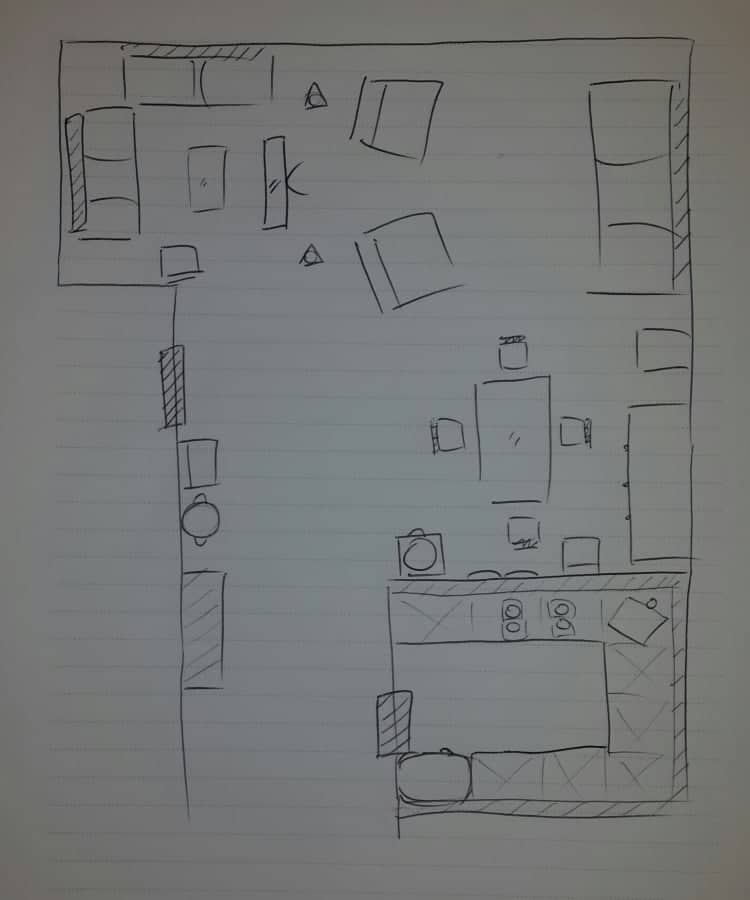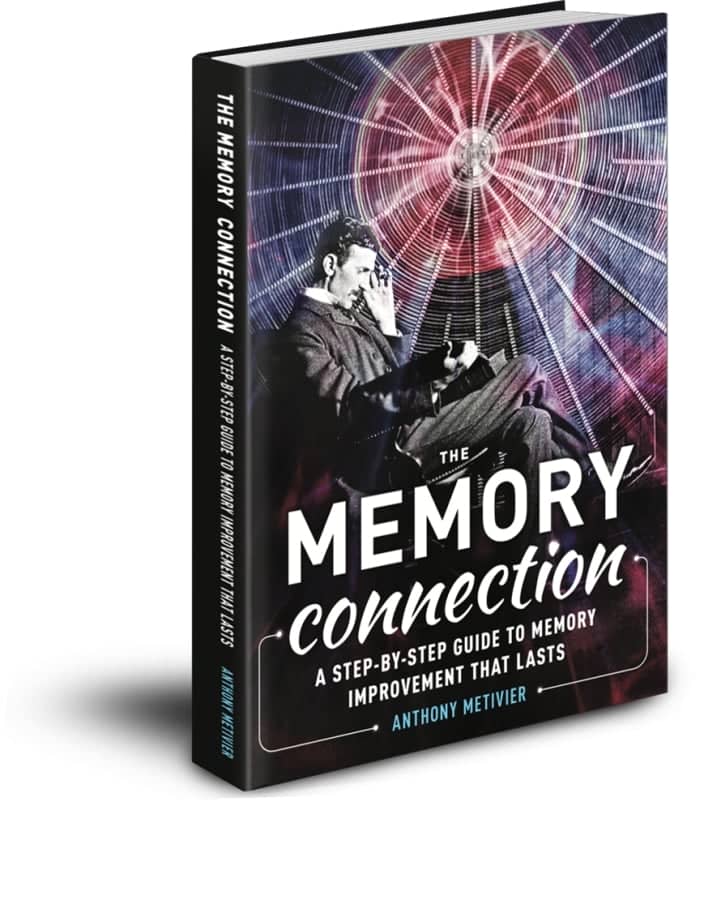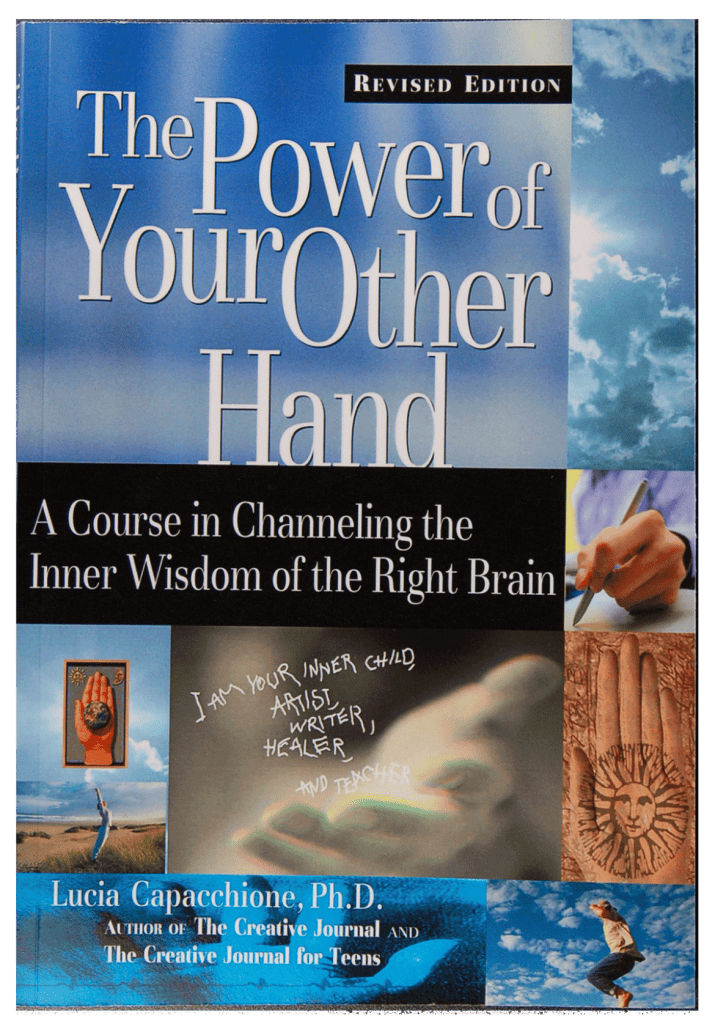Podcast: Download
Subscribe: Apple Podcasts | RSS

Midway through a gig, can you swing the guitar to your left arm and continue strumming the ballad?
If you can, you are part of that 1% of the population who do not have a dominant hand and experience ambidextrousness.
And as you’re about to discover, ambidextrousness truly is an experience!
If you are ambidextrous, you’re in good company too. Or at least, interesting company.
Other members of this ‘exclusive’ group include Benjamin Franklin, Kobe Bryant, and even Nikola Tesla, just one of many reasons I featured him on the cover of The Memory Connection:
Many people believe training oneself to use both your hands equally unleashes hidden creativity and even improves memory.
The idea that becoming ambidextrous boosts brain function has existed for over a century.
Moreover, it is also claimed that if you harness this ‘power’ you can improve your academic performance, decision making skills and grasp difficult concepts quickly.
Can ‘learning’ to become ambidextrous really have all these advantages?
Let’s find out.
Ambidextrousness: A Dual Handed Benefit?
There is a bit of confusion regarding the actual definition of ambidextrousness.
You are ambidextrous, if you can perform any task equally with either hand, for instance, write legibly using either of your hands.
However, if you do some tasks with your right hand and others with your left, experts will term it as being mixed-handed.
Jimi Hendrix is a good example of mixed-handedness. He used his left hand to throw and comb his hair, but he wrote, ate and held the telephone with his right hand.
How To Become Ambidextrous?
(Because Few Are Born This Way)
In the 1800s Paul Broca and Carl Wernicke discovered that different hemispheres of the brain handled different functions such as speech, language and even motor functions.
But it was only in 2009 that scientists researched around 25,000 families and found certain genes were responsible for ambidextrousness in people.
Then in 2015, researchers found that brain function within the cerebellum is responsible for creativity.
This certainly proves why many ambidextrous people have unconventional problem solving abilities.
If you want to develop these skills, multi-sensory neurobics exercises are your best bet. This is because they amp up your ability to use both hands. For example, you can learn to write backwards with your dominant hand first and then do so with your non-dominant before switching from left to right.
Yes, it’s a mind bending brain exercise. But that’s precisely the point. Without stretching yourself, you cannot experience growth. Part of what it takes to become a creative genius is willfully exposing yourself to challenges.
Creative Geniuses, Or:
The Celebrities Of Ambidextrousness
Nearly 60 years after his death, neurosurgeons studying Einstein’s brain discovered that his brain hemispheres were extremely well-connected. The ability to use the right hemispheres creativity and the left hemispheres logic gave the Father of Relativity a significant advantage from his peers.
Despite a lack of evidence proving Einstein’s ambidextrousness, the study confirmed Einstein’s non right-handedness.
Another historical figure who belonged to the ambidextrous club was Leonardo Da Vinci. The famous artist (and scientist of art) could easily write with both hands.
When Da Vinci wrote an ordinary letter, he used his right hand.
However, he wrote his secret diaries in mirror writing using his left hand which made it difficult for others to read. I’ll bet he used some of these visualization exercises too.
Are All Ambidextrous Individuals Creative Geniuses?
Not really!
Left-handed tennis player Evgenia Kulikovskaya can switch her racket hand mid game to keep hitting forehands when her left hand gets tired. She doesn’t have a backhand!
Take a look at this video:
The Controversial History Of Ambidextrous Training:
John Jackson
Though many modern studies link ambidextrousness with increased brain function in both hemispheres of the brain, this idea was not well received at first.
In 1905, English educational reformer, John Jackson established the Ambidextral Culture Society. He believed that a two handed, two brained society encouraged superior learning as it engaged the entire brain.
He also expected a lot from his disciples. Whether it was playing the piano with one hand or writing a letter with the other, he required his disciples to execute them flawlessly.
Was he successful in his mission?
Not quite.
His society was a laughing stock of the scientific community at the time.
Leading British neurologist, James Crichton-Browne criticized the society and even warned Jackson against going the evolutionary process.
John Jackson’s movement died out in the 1920s.
However, his ideas did not. They continued to fuel misconceptions regarding the power of ambidextrousness.
Can Being Ambidextrous Make You More Creative?
A Few Myths Busted
Jackson’s theories were not random ideas. They were derived from Paul Broca’s studies of brain lateralization that states that some cognitive brain activity is dominant in one hemisphere, and that each hemisphere was linked to the opposite hand.
No wonder people believed that using your less dominant hand would help activate both hemispheres of the brain leading to higher mental abilities.
That’s just the beginning…
In her book, The Power of Your Other Hand, Lucia Capacchione claims that writing and drawing with the non-dominant hand gives greater access to the right hemispheric functions like feeling, intuition, creativity and even spiritual wisdom.
These claims are based on the fact that the function of the right hemisphere is responsible for creativity.
Is there any truth to these claims?
“Although there are recurrent claims of increased creativity in left-handers, there is very little to support the idea in the scientific literature.”
This from renowned psychologist Chris McManus in his book Right Hand, Left Hand – The Origins of Asymmetry in Brains, Bodies, Atoms and Cultures.
The Truth About Learning To Be Ambidextrous
And Getting A Sharper Brain
While there is no hard data to prove that training your non-dominant hand can improve your mental prowess, there is now evidence to state that if you are born ambidextrous, you may have some mental health issues.
After 8 years of research, German psychologist, JB Sattler discovered that children who switched from their dominant left hand to a non-dominant right or the reverse did not see “a change in cerebral dominance but rather a multifaceted cerebral disturbance or damage”.
The psychologist noted that ambidextrous children even had decreased memory for all three areas of information processing – encoding, store and recall.
Sattler said: “Ambidexterity is therefore neither a goal to aspire to nor is it a gift from God. Instead, it is first and foremost the mark of brain damage.”
It May Sound Crazy, But It’s True!
A study published in the 1998 edition of Neuropsychologia confirms Dr. Sattler’s research.
In this study around 12,770 children were tested for their verbal, non-verbal, and mathematical ability and reading comprehension skills. They found that ambidextrous children had lower test scores as compared to those who were left-handed or right-handed.
Need more proof?
Another independent study led by Alina Rodriguez from Imperial College London showed that ambidextrous children exhibit higher symptoms of Attention Deficit Hyperactivity Disorder (ADHD).
Ambidextrousness may also have a lasting effect on adults as well.
In the creatively titled paper “Handedness and intellectual achievement: an even-handed look”, Michael Corballis reveals that ambidextrous adults perform more poorly on IQ tests (arithmetic, memory, and reasoning).
Ambidextrousness May Actually Harm Your Brain
Here’s why:
For right-handed or left handed people most of their brain activity is localized in the opposite part of the brain. So your brain can easily access information through the majority of one hemisphere.
For ambidextrous people information has to flow back and forth between both hemispheres of the brain through the Corpus Callosum.
This can be a big problem.
This rapid transfer may lead to mental dysfunction in some cases.
Are There Any Possible Benefits to Ambidextrous Training?
Yes, though they are not as dramatic as advertised.
Mr. Corballis writes that it’s possible to train your non dominant hand for artistic purposes – like playing the piano for example.
Other than that, there are no studies to prove that becoming ambidextrous can improve brain function.
But what about improved memory?
Ambidextrousness and Memory: A Genetic Connection
Ambidextrous tendencies has been associated with improved memory.
But here’s the catch:
To reap even the slightest memory benefits of ambidextrousness, you would be need to have at least an ambidextrous parent or sibling.
A 2001 study shows that families with one-left handed member may have better episodic memory rather than semantic memory.
Which means they have a better time recalling the context of the story rather than the facts present in the story.
The Only Trick You Need To Know To Make
Both Sides of Your Brain Work
There is one guaranteed method to improve both your episodic and semantic memory as well as autobiographical memory, spatial memory and procedural memory.
One more thing..
This method won’t be painful and labour intensive as using your non dominant hand. (Of course, you can use both hands to draw them for the extra boost if you wish!)
Okay here it is:
Creating Memory Palaces the Magnetic Memory Method way.

Memory Palace drawing by Olly Richards
Memory Palaces have the unique characteristic that all other memory techniques can be used inside of them (not the other way around).
So if you need to store a massive amount of information, Memory Palaces engage both hemispheres of the brain.
How do they do this?
Memory Palaces require a great deal of creative visualization, therefore it helps to activate your right hemisphere associated with creativity.
You need more than one Memory Palace and as many as possible. That way you can revisit the technique to recall tons of information.
If you want to know more – here’s some vital information about Memory Palace Science.
If you want a complete brain workout try this brain fitness method…
Click on the link below to get started:
A Direct method To Improve Your Memory
Learning to use your non-dominant hand to improve your memory can be a bit wasteful. You would have to spend days and weeks practicing to write with your other hand instead of focusing on what you need to learn.
While this may be fun, it’s not useful.
Memory improvement training should always be linked to memorizing information that will immediately improve your life.
Using the Magnetic Memory Method is great because, once you’re rolling, good memory abilities get you more time.
More time means you can practice memory enhancing techniques more often.
And that means experiencing better memory, better focus, clarity and concentration. Especially when you’re studying tough subjects.
Ambidextrousness might be fun to develop if you take caution.
But, as we’ve seen, developing your memory is far more valuable!
So, what are you waiting for?
Please make sure you’ve claimed my free Memory Improvement Kit and use it to start experiencing better memory now.










Another great article Anthony! I’ve been interested in this for a long time as my husband is multi handed. He does certain things with one hand (eg cuts bread, meat etc with left hand) and other things with the other hand (eg writes – he says because he was made to at school). His son is left handed. Fascinating about the link to memory. I’ll tell him he needs to do a memory course!
Thanks for this, Rosemary, and interesting to learn about your husband’s experience.
How is your husband’s penmanship?
Thanks for recommending that he take a memory course. There are many out there to choose from, to be sure. Is there any particular area of memory he would benefit from improving the most? (I.e. for language learning, names, facts, etc.?)
I am a ambidextrous since I was 8 year old and I never found any problem in storing memory. But now when I am 19 years old I am finding problems in learning. Can you help me?
Thanks for sharing your experience, Aryansh.
I can certainly help you help yourself. I suggest taking the free course I offer and completing all the steps. Then, if you have questions, send them along, or post them on the MMM Forum.
I suggest that all people have a specific learning goal to work with as they go through the training. For example, I am currently learning Chinese and memorizing Sanskrit texts.
Think about what large learning project you can take up and use memory techniques to help. That is generally the best way to make progress rapidly and develop these skills so they last for life.
I am also ambidextrous and now I’m having problems remembering stuffs and that has cost me a great deal. Does that mean I will have to focus on being one handed in order to improve my condition?
Thanks for your question, Stephen.
I do not think you need to make handedness changes. Rather, I think you’d be best served to take some memory improvement training. Have a long term learning project too, like a language or a topic in history.
To relax myself I will sit down and write with both my hands at the same time and sometimes if I really want to stretch my brain I can do two different words at the same time. I thought this was good for me however I’ve been reading lately that it could be harmful but all the articles are only about people who can write with their left and then their right and I can’t find anything really anywhere about being able to use both at the same time. I would like to learn more.
Thanks for this, Stu.
I find it unlikely that anyone would create self harm by writing with both hands at the same time.
From the MMM perspective, the question is one of the exact desired outcome. If it’s for relaxation, practice this skill in a way that creates that outcome.
If it’s for brain exercise, combine it with semantic content that will exercise your brain, such as mathematical calculations or working to recall foreign language vocabulary.
I want to learn to write with my non dominant hand. Is this bad for my brain ?
I have practiced doing this and noticed only good effects.
However, if you’re concerned, please consult a doctor.
I want to become ambidextrous. Is it lead me to any brain damage?
Thank you for your question, Anish. As indicated elsewhere in this discussion, I cannot see why it would cause such a problem. However, you must direct such questions to medical professionals who are qualified to give an answer.
Thank you for giving us such a good information.
My pleasure!
I’m not only ambidextrous but I can draw a house with a pen in each hand and and at the same time draw a symmetrical image. Is this normal for ambidextrous people?
Which hand is drawing the symmetrical image while your other two are drawing houses? What is the symmetrical image?
I am 15, do you have any advice for what habits and things I should do to improve my brain function and memory?
I do.
I would suggest learning the Memory Palace technique.
I am curious as to what my wifes ability to write seperate sentences at the same time means? What do you call her ability? She is wicked smart in math, yet ambidextrous. I have seen ithers draw, or paint and even write with both hands. I have never seen anyone like her that when prompted writes mirrored and backward as well. Is there a name for what she does? I started advertising her abilities and she was not pleased and even embarrassed as she thinks ambidextrous people on whole are lower IQ’d ???
Sincerely,
Rowland Whitsell
Harry Kahne would have called that skill multiple mentality.
I’m unaware of any association to IQ, however, nor how it would be a useful metric in these realms.
I’m deliberately learning to be ambidextrous, and it’s a fascinating adventure.
I’m inclined to think that there is a “hump” in the process whereby, if you don’t persevere, you can find yourself “stuck.”
I’m currently learning drums, and am teaching myself to lead with my left (non dominant) hand. There’s a huge internal resistance to it, as I can feel my brain is wired to lead with the right. Even when I’m leading with the left it seems that the instructions to do so are coming from the left side of my brain, which is of course what leads the right.
But as I’m learning about locus of control, it seems to me that what makes the dominant hand so is that the dominant side (the left brain in right handed people) has a stronger internal locus of control than the non dominant. The issue with handedness is, perhaps, in locus of control and perhaps no more than that. If the frontal lobes in my non dominant hemisphere aren’t connecting as well to the basal ganglia of the same side, it stands to reason that my non dominant side will be more prone to impulsive behavior, and “I” won’t have as much control over it.
What I am aware of is as I make decisions on behalf of my non dominant self, there are clear neurophysiological occurrences happening immediately. My body senses, and prepares, for the coming tasks, as it were. In particular I noticed this effect when I decided to restring a guitar left handed. The moment I decided, I felt a shift in the energy in my left side. It was a remarkable experience!
So I’m inclined to think that what’s happening when we choose ambidexterity is that the non dominant side “wakes up” and that “waking up” can cause a degree of havoc, since the non dominant side is seeking agency.
So part of the process is to make sure that both sides “get along”.
If you follow the work of Roger Sperry and his split brain experiments, it seems that our two hemispheres are discrete entities. There is a left me and a right me. And if we aren’t kind to our non dominant self, and involve it in our lives, it can retaliate.
But if we can truly acknowledge our non dominant self, and integrate it into our lives, it and our dominant self can become the best of buddies and true allies.
Although Sperry “split” the Nobel Prize with someone else, I’m not sure there’s consensus on his findings. They certainly created quite a watershed, but there are alternative theories that may win out.